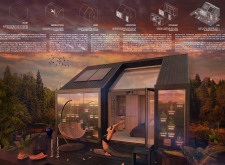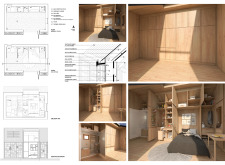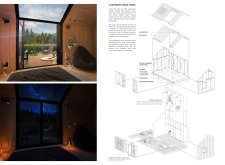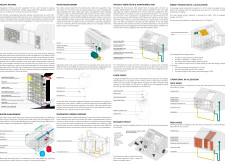5 key facts about this project
The prefabricated off-grid cabin is designed for individual use and located in Ozolini, Latvia. It emphasizes sustainability and energy efficiency, while fostering a close connection with the natural surroundings. The cabin's layout is oriented along the east-west axis, which optimizes solar exposure. This design choice enhances the effectiveness of passive heating strategies, allowing the structure to minimize reliance on external energy sources. The overall concept reflects thoughtful consideration of the environment, resulting in a functional and integrated design.
Cuboid Volume and Orientation
The cabin stands as a simple cuboid shape that faces south to capture sunlight throughout the day. This orientation improves passive solar heating and contributes to energy efficiency. Large door-window-skylight openings between interior and exterior spaces allow natural light to fill the cabin. These design features also provide striking views of the surrounding landscape, making nature an integral part of the living experience.
Integration of Trombe-Green Wall
A key component of the design is the Trombe-green wall positioned on the south facade. This element has two main functions: passive heating and air purification. The use of vegetation on the wall not only improves indoor air quality but also helps maintain comfortable temperatures inside. This addition highlights a modern approach to sustainable design, illustrating a commitment to using natural elements for the benefit of the occupants.
Dynamic Interior and Functional Layout
Inside, the cabin utilizes a dynamic cupboard-like wall that offers various functions within a compact space. This innovative aspect integrates essential components such as a closet, bed, kitchenette, and toilet into one unit. The layout encourages adaptability, allowing residents to adjust the space according to their needs. This functionality promotes comfort and creates a suitable environment for rest and meditation.
Materiality and Aesthetic Consideration
The chosen materials include wood, straw, and wood fiberboards, which align with the project's sustainable intent. Using natural materials reduces the ecological footprint and keeps embodied energy low. The exterior is finished in black, which absorbs sunlight and assists with passive heating. This color choice creates a calming visual effect that blends with the landscape. Carefully placed windows frame picturesque views, connecting occupants closely with nature and enhancing the overall living experience.
The cabin’s design highlights a clear relationship with its environment, combining practical functions with a respect for natural elements. Each aspect is thoughtfully executed, resulting in a structure that serves the needs of its inhabitants while harmoniously coexisting with the landscape.






















































